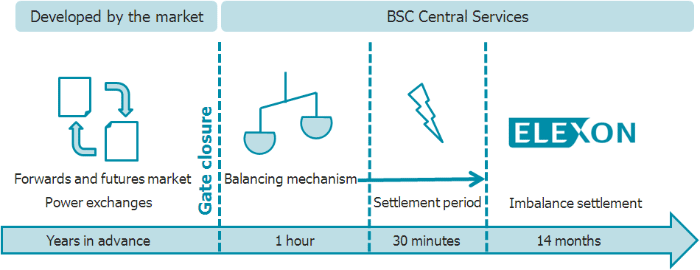Settlement & Invoicing
This page sets out the various areas that are important when understanding the balancing and settlement processes when trading in the GB electricity market.
On this page
Settlement
For each half hour, known as a Settlement Period, companies can trade up to 1 hour beforehand that time period is closed. This is known as Gate Closure.
Following Gate Closure, National Grid uses the Balancing Mechanism to balance the system. Contract notifications, bids and offers, and other data, is sent to BSC Central Services for Imbalance Settlement.
Video on the Introduction to Imbalance Settlement
Settlement Calendars
There are several Settlement Calendars covering the various Settlement Systems. Use our Portal to search and download these Settlement Calendars for particular Settlement or Agent Run dates.
Settlement Periods
For the purposes of trading and settlement, electricity is considered to be generated, transported, delivered and used in half hour chunks called Settlement Periods.
Settlement Periods are always based on local time. Period 1 is always 0000hrs (midnight) local time. A Normal Day has 48 Settlement Periods, whereas a Short Day (clocks go forward) has 46 and a Long Day (clocks go back) has 50. A conversion table between Settlement Period and Local/GMT Time is shown below:
|
SETTLEMENT PERIOD |
WINTER |
SHORT DAY |
SUMMER |
LONG DAY |
|||
|
GMT |
GMT |
BST |
GMT |
BST |
BST |
GMT |
|
|
1 |
0000 |
0000 |
|
2300 |
0000 |
0000 |
2300 |
|
2 |
0030 |
0030 |
|
2330 |
0030 |
0030 |
2330 |
|
3 |
0100 |
0100 |
0200 |
0000 |
0100 |
0100 |
0000 |
|
4 |
0130 |
0130 |
0230 |
0030 |
0130 |
0130 |
0030 |
|
5 |
0200 |
0200 |
0300 |
0100 |
0200 |
0200 |
0100 |
|
7 |
0300 |
0300 |
0400 |
0200 |
0300 |
|
0200 |
|
9 |
0400 |
0400 |
0500 |
0300 |
0400 |
|
0300 |
|
… |
… |
… |
… |
… |
… |
|
… |
|
41 |
2000 |
2000 |
2100 |
1900 |
2000 |
|
1900 |
|
43 |
2100 |
2100 |
2200 |
2000 |
2100 |
|
2000 |
|
45 |
2200 |
2200 |
2300 |
2100 |
2200 |
|
2100 |
|
47 |
2300 |
|
|
2200 |
2300 |
|
2200 |
|
48 |
2330 |
|
|
2230 |
2330 |
|
2230 |
|
49 |
|
|
|
|
|
|
2300 |
|
50 |
|
|
|
|
|
|
2330 |
GSP Group Correction Factors
GSP Group Correction Factors (GGCFs) are used to ensure that the total energy allocated to Suppliers in each Settlement Period in each GSP Group matches the energy entering the GSP Groups from the transmission system, adjoining GSP Groups and through embedded generation.
Imbalance Pricing
The Imbalance Price is used to settle energy imbalance volumes. At the end of a Settlement Period, BSC Systems compare a Party’s contracted (traded) volume with the metered volume of energy used in the Settlement Period. If a Party is in imbalance of its contracted volume, then it will be subject to imbalance charges.
Trading Charges
Each Trading Party is liable to pay or receive Trading Charges for each Settlement Day. These charges are calculated in relation to Imbalance Settlement and Balancing Mechanism activity. The Settlement Administration Agent (SAA) determines the trading charges.
Maintaining Credit Cover
The purpose of Credit Cover is to ensure that, should a Trading Party default, sufficient collateral is available to pay any debts. If a Party does not have sufficient funds it will enter into Credit Default.
Transmission Losses
Losses on the Transmission System are allocated across BSC Parties through the use of Transmission Loss Multipliers (TLMs). Transmission Loss Factors exist for each TLF Zone (aligning with the existing Grid Supply Point Groups) for each BSC Season in order to allocate transmission losses on a geographical basis.
Profiling
DA Load Profile represents the pattern of electricity usage by day and by year for the average customer in each one of the eight Profile Classes.
We create Profiles (daily, seasonal, yearly, per day type, etc.) for each of the eight Profile Classes by randomly selecting sites and installing half-hourly meters at these sites or getting half-hourly consumption data directly from Suppliers. These samples are designed to provide Profiles that are representative of all meters in each Profile Class.


